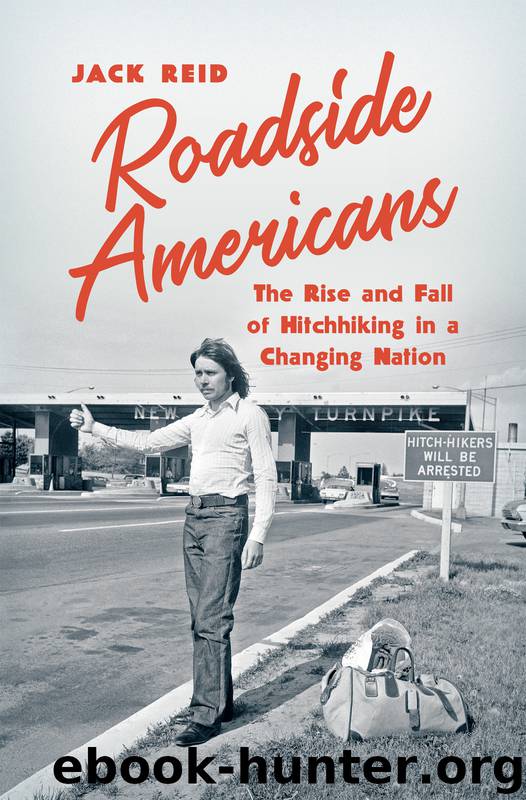Roadside Americans by Jack Reid

Author:Jack Reid
Language: eng
Format: epub
Publisher: The University of North Carolina Press
Published: 2020-06-15T16:00:00+00:00
ALTHOUGH HITCHHIKING dovetailed with the ambitious optimism and sporting sensibility of the 1960s, the practice did encounter some governmental resistance amid growing regulatory efforts to foster traffic safety. Notably, the Eisenhower administration had responded to rising numbers of traffic accident deaths in the 1950s with the “Crusade for Traffic Safety” program. Ultimately, however, this media relations campaign did little to reduce traffic fatalities, which grew at an alarming rate into the 1960s. As a result, government safety commissions—staffed with insurance company representatives—and a number of special interest groups began to fight for legislation to regulate and optimize safety on the nation’s roadways.
These efforts eventually resulted in the passage of the National Traffic and Vehicle Safety Act of 1966, which created the National Highway Safety Bureau (NHSB). This federal agency was organized to regulate automotive and roadway safety standards. Consequently, the federal government worked to improve the nation’s road systems, creating greater barriers between oncoming traffic while also making curves more manageable for motorists. They also added reflectors to encourage greater visibility at night. At the same time, the NHSB pushed for vehicles to be built with new safety features, such as safety belts, shatter-resistant windshields, and headrests to keep motorists’ heads from snapping back. The federal government also urged states to pass motorcycle helmet laws in 1967, even threatening to withhold federal highway construction funds for those who resisted.85 In the end, these reforms were responding to legitimate traffic safety issues, but they also highlight how the postwar United States was moving toward a more risk-averse, regimented, and bureaucratic social organization where drivers were forced to sacrifice a degree of personal freedom for the greater public good.
Although hitchhiking experienced a renaissance in popularity during this era, the reality of increasing automobile and roadway regulations nonetheless complicated the practice’s viability as common pedestrian accidents also began to attract greater attention. As a result, broader state and local government efforts to promote traffic safety began to target hitchhikers—framing the elimination of thumbing rides as a step toward protecting pedestrians and motorists alike. Notably, the very things that made hitchhiking exciting to young people—its unstructured and unpredictable nature—clashed with the message of these safety campaigns. Within this context, police officers targeted high school students hitchhiking on busy intersections because their presence often led to automobile collisions when cars stopped suddenly.86 Penalties varied among cities and towns, though fines were common. In some areas, repeat offenders faced the possibility of juvenile detention. As a Butte, Montana, officer explained, “We do not like to have to take such action, but it is a matter of safety, both for motorists and the boys themselves.”87 Yet the volume of young hitchhikers versus the number of officers meant that police often fought an uphill battle.
Hitchhiking on limited-access highways received the most stringent regulation as officers sought to limit high-speed collisions and fatalities. States such as New York and California monitored expressways more closely than other highways and warned hitchhikers to stay off these roads. Notably, as in he
Download
This site does not store any files on its server. We only index and link to content provided by other sites. Please contact the content providers to delete copyright contents if any and email us, we'll remove relevant links or contents immediately.
| Africa | Americas |
| Arctic & Antarctica | Asia |
| Australia & Oceania | Europe |
| Middle East | Russia |
| United States | World |
| Ancient Civilizations | Military |
| Historical Study & Educational Resources |
Underground: A Human History of the Worlds Beneath Our Feet by Will Hunt(12022)
Sapiens by Yuval Noah Harari(5293)
Navigation and Map Reading by K Andrew(5111)
The Sympathizer by Viet Thanh Nguyen(4305)
Barron's AP Biology by Goldberg M.S. Deborah T(4096)
5 Steps to a 5 AP U.S. History, 2010-2011 Edition (5 Steps to a 5 on the Advanced Placement Examinations Series) by Armstrong Stephen(3687)
Three Women by Lisa Taddeo(3353)
Water by Ian Miller(3126)
The Comedians: Drunks, Thieves, Scoundrels, and the History of American Comedy by Nesteroff Kliph(3039)
Drugs Unlimited by Mike Power(2544)
A Short History of Drunkenness by Forsyth Mark(2233)
DarkMarket by Misha Glenny(2158)
The House of Government by Slezkine Yuri(2158)
And the Band Played On by Randy Shilts(2127)
The Library Book by Susan Orlean(2041)
Revived (Cat Patrick) by Cat Patrick(1962)
The Woman Who Smashed Codes by Jason Fagone(1929)
Birth by Tina Cassidy(1864)
The Absolutely True Diary of a Part-Time Indian by Sherman Alexie(1855)
